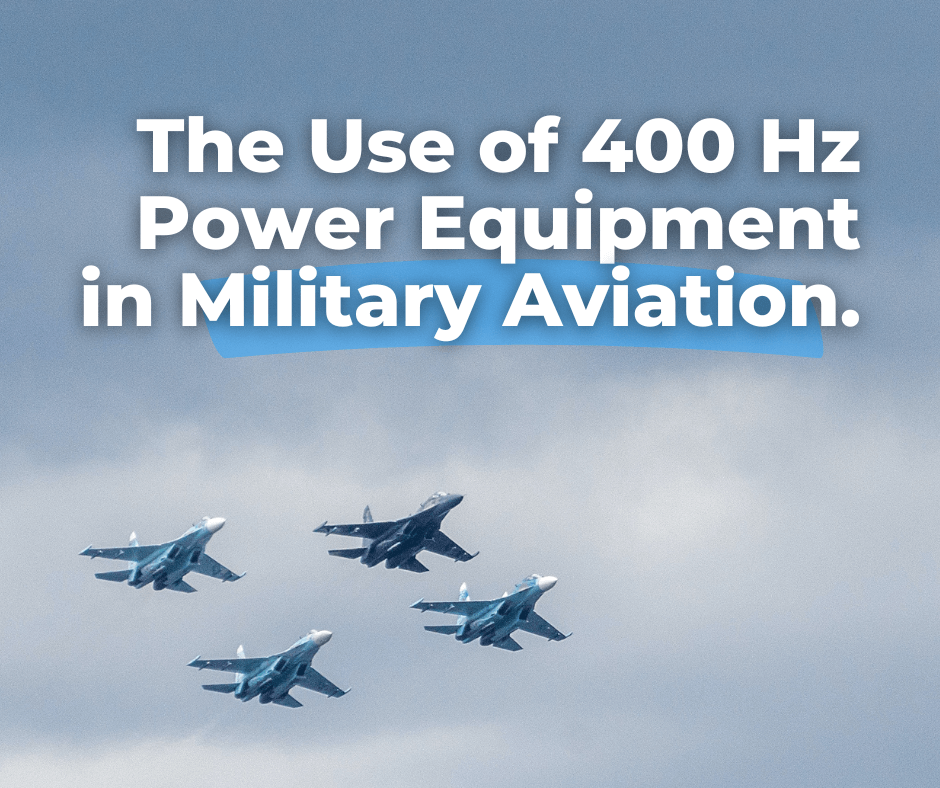(ENG) Exploring the Use of 400 Hz Power Equipment in Military Aviation.
This question often arises within our professional field, and the answer is quite straightforward.
The use of 400 Hz power significantly reduces the size and weight of the engine and other components, improving aircraft maneuverability and reducing overall weight. This results in faster reaction times and improved agility in combat or tactical operations. In addition, the impact on fuel efficiency is also significant. A lighter aircraft requires less fuel to operate, resulting in greater range and endurance. This allows military aircraft to cover longer distances or remain airborne for longer periods of time without the need for frequent refueling.
In addition, the lighter weight of the aircraft creates additional capacity to carry critical equipment, weapons, supplies or additional fuel. This increases the payload capacity and overall operational versatility of the aircraft. Most importantly, the lighter weight allows military aircraft to reach higher speeds, enabling quick response times and rapid arrival at desired targets. The 400 Hz power is used not only in military aviation, but also in civil aviation, since operating at this frequency provides a balance between the weight, size, and efficiency of the electrical equipment used in aircraft.
Why use Sinepower 400 Hz frequency converters to power your military aircraft on the ground?
On the ground, the aircraft’s engines and the onboard turbo generator Auxiliary Power Unit (APU) do not need to be kept running continuously. Sinepower’s 400 Hz Frequency Converters equipment supplies serve as an alternative to using the aircraft’s onboard auxiliary power unit (APU) or engines for generating electrical power, reducing fuel consumption and emissions while the aircraft is stationary. In maintenance hangars, for example, the aircraft’s engines cannot run in the hangar.
By using Sinepower 400 Hz frequency converters, aircraft can shut down their engines or APU while on the ground, reducing noise pollution and fuel consumption. This results in cost savings for airlines and a reduction in carbon dioxide emissions, contributing to environmental sustainability.
Furthermore, Sinepower 400 Hz frequency converters provide a stable and reliable power source for the aircraft, ensuring a constant and uninterrupted power supply. This is particularly important during sensitive operations such as avionics checks, maintenance work or passenger boarding, where a constant power supply is essential. Main advantages are:
Efficiency.
The main advantage of using Sinepower 400 Hz frequency converters is its energy efficiency. Sinepower units have up to 95% efficiency. The Sinepower 400Hz frequency converters only need to be activated when necessary allowing for a green standby mode where all power is turned off, so the unit is ready in standby mode when the need for power arises. This provides additional savings as the unit responds to power demand.
Eco and maintenance-friendly.
The Sinepower 400 Hz frequency converter offers several benefits, including the elimination of noise and air pollution, the reduction of unnecessary fuel consumption, lower maintenance costs, resulting in cost savings and higher operational efficiency.
Why is easier-to-maintain power equipment critical for military aviation?
- Operational readiness: military aircraft must be operational at all times to respond to missions or emergencies. Simplifying maintenance procedures reduces the time required for inspections, repairs, and servicing. This allows aircraft to spend more time in active service and minimizes maintenance-related downtime.
- Cost efficiency: Streamlining maintenance processes for power equipment helps reduce maintenance costs in terms of labor, resources and spare parts. By using equipment that is easier to maintain, the military can allocate resources more efficiently and effectively.
- Fast changeover: In military operations, quick turnaround times between missions are crucial. When engine equipment requires complex or time-consuming maintenance, it can affect the aircraft’s ability to be quickly returned to service.
- Flexibility and mission readiness: military aviation frequently operates in diverse and challenging environments. Easier-to-maintain propulsion equipment increases aircraft flexibility and mission capability. Maintenance can be performed in a variety of locations, including remote or austere environments, without the need for extensive infrastructure or specialized tools.
- Mission effectiveness: Simpler maintenance procedures reduce the risk of equipment failure or malfunction during critical missions. This ensures that the aircraft can perform its intended mission without disruptions or compromised performance.
- Safety and risk reduction: When maintenance tasks are simple and well-documented, the likelihood of errors or omissions that could compromise safety or increase operational risks is reduced.
Overall, it is crucial to acquire highly efficient and effective power equipment, especially in the demanding industry of military aviation. With the safety of your personnel, equipment, and missions in mind, we specialize in designing comprehensive power equipment. Please don’t hesitate to contact us for further information.

